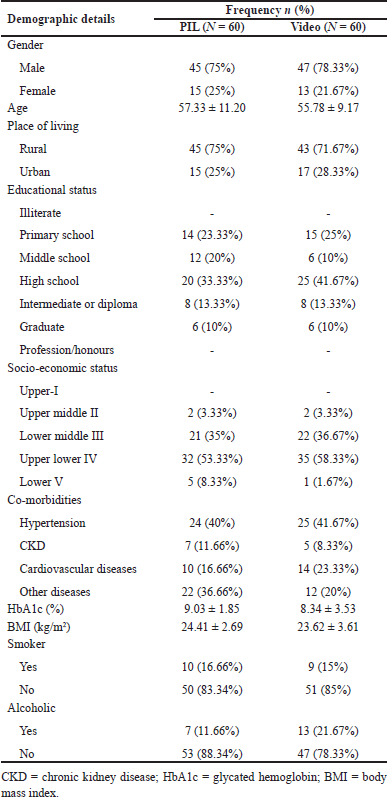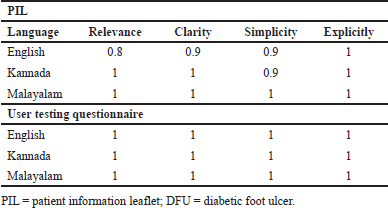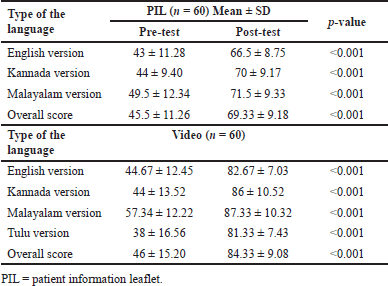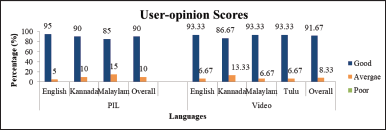INTRODUCTION
Diabetes mellitus (DM), a chronic metabolic disorder, can lead to several complications such as diabetic foot ulcer (DFU), especially when poorly managed. DFU affects patients’ quality of life (QoL) and poses a substantial financial burden [1,2]. Multiple factors contribute toward the worsening of DFU: e.g., illiteracy, low socioeconomic status, improper footwear, barefoot walking, lack of knowledge of DFU, shortage of qualified medical personnel and inadequate patient counseling, and ignorance regarding diabetic foot care [2,3]. Patient education is “the process by which healthcare professionals and others impart information to patients that will modify their health behaviors or improve their health status.” Therefore, patient education is a key to successful treatment plan with better self-management [4]. Patient’s awareness of foot care is vital and should be improved through diabetic foot care education [1]. Patient information leaflets (PILs) are widely used to educate patients and the community about drugs, illnesses, and lifestyle changes. Validated PILs can ensure information is communicated clearly without a doctor’s intervention and help avoid misconceptions. PILs help patients to remember important information, and improve satisfaction and compliance in conjunction with doctor-patient interaction [1,2,5,6].
Similar studies have shown that health education videos are effective tools for teaching patients in multiple healthcare settings. Video interventions are very useful in developing countries for educating poorly educated patients about their health problems and drugs. Many have reported that knowledge among the patients improved after implementing collaborative healthcare interventions employing professionally assisted educational videos about signs, symptoms, treatment, risk factors, and preventive methods [7–9].
Peer-reviewed literature has extensively examined the degree of knowledge improvement with PILs and instructional videos in diverse patient settings all over the world [1,2,5–10]. In the current study, we aimed to compare PILs and audio-visual aids in imparting knowledge about DFU to patients.
MATERIALS AND METHODS
Study design, sample size, site, and study criteria
This pre and post-test quasi-experimental study without a control group was carried out over 1 year, and involved 120 DFU patients above18 years, from a tertiary care teaching hospital in Mangaluru. Those who could read and understand English, Kannada, Malayalam, or Tulu languages were enrolled after obtaining informed consent. Patients with cognitive, psychiatric, and other terminal illnesses were excluded from the study.
Based on a pilot study, the standard deviation in the PIL group is 10.96 and video group 16.34, the mean difference is 7.1%, the effect size is 0.5201, α error is 5%, the power is 80%, and two-sided test sample required per group is 60. The sample size was calculated using nMaster software version 2. In this study, the convenience sampling method was used and participants were allocated nonrandomly in the two groups.
Data collection
The socio-demographic details such as age, gender, socio-economic status [11], domiciliary status, comorbidities, body mass index, glycated hemoglobin, smoking, and alcoholic history were obtained through patient interviews and case files and recorded using a data collection form.
Ethical consideration
Before the start of the study, ethical approval was obtained from Nitte (Deemed to be University), Central Ethics Committee, Mangaluru. The study was registered in the Clinical Trials Registry- India (CTRI) - CTRI/2020/12/029603.
Study procedure
Development of content of PIL and video
Content of the PIL and videos in English was developed with the help of (a) peer-reviewed literature and (b) treatment guidelines regarding signs and symptoms, causes, foot wash procedure, daily visual assessment of the foot, wound dressing, toenail cutting, the importance of footwear and preventive measures. Pictograms were used in PIL and in videos both pictograms and the demonstration of the foot care procedures such as washing and moisturizing the feet, toenail cutting, and selection of footwear were included. The text used in local language videos was in English and the audio was in local languages such as Kannada, Malayalam, and Tulu. The average length used in videos was 5 minutes. Healthcare experts validated the content. The final video in English was created with the help of multimedia experts [1,8,9,12].
Validation of the PIL
The content, design, and pictograms of the PIL in the English language were validated by an expert panel which included physicians, nurses, and pharmacists. A total of 10 experts (physicians, nurses, and pharmacists) validated the PIL. Experts also rated the content of the PIL on a four-point Likert scale. The PIL was then translated into local languages (Kannada and Malayalam) with the help of local language experts and validated further by forward translation, backward translation, and pilot testing. The content validity index (CVI) value above 0.75 was considered acceptable for including the content in PIL [13].
Validation of the video
In accordance with Delphi procedures, physicians, pharmacists, nurses, and multimedia experts validated the final video in English. A total of 10 experts (physicians, pharmacists, nurses, and multimedia experts) validated the videos. Then, the validated video in English was translated into local languages (Kannada, Malayalam, and Tulu), and further approved by local language experts. Videos in different languages were validated using the four-point Likert scale (very irrelevant, irrelevant, relevant, and very relevant), and the cut-off point of the video content validity was >80% (cumulative agreement of relevant and very relevant) [1].
Readability of the PIL: Flesch reading ease (FRE) and FKGL scores
PIL’s readability was assessed by FRE and Flesch-Kincaid grade level (FKGL). The scores of FRE between 60 and 70 are considered “standard,” 70 and 80 as “Fairly Easy,” and 80 and 90 as “Easy,” whereas an FKGL score of above 6 can be understood by a sixth grader and above 7 can understand by seventh grader [4,5,14,15].
Design, layout, and content of PIL: Language-wise Baker able leaflet design (BALD) criteria scores of PIL
The BALD criterion was used to assess the leaflet layout and design. A BALD score above 25 or more is considered “above standard” and 20–25 is considered “standard” [4,5,14,15].
Development and validation of the DFU user-testing questionnaire
Based on the PIL and video content, a total of 16 multiple-choice questions were prepared in English and validated by physicians, pharmacists, and nurses. A total of 10 questions were finalized based on expert opinion, and the same were translated into local languages (Kannada and Malayalam), and validated by local language experts. The DFU user-testing questionnaire content was validated based on relevance, clarity, simplicity, and explicitly on a four-point Likert scale. Questions with scores above 0.75 were included in the questionnaire [13]. The same validated questionnaire measured the change in knowledge through a pre-test and post-test.
Reliability of DFU user-testing questionnaire
The finalized DFU user-testing questionnaires in English, Kannada, and Malayalam were administered to 10 patients in each language, on days 1 and 7. Cronbach’s alpha test assessed the reliability of the questionnaire in each language. A Cronbach’s value of 0.70 or above indicated good internal consistency of the questionnaire [5].
User-testing scores of the PIL and video
The user-testing score of the readability of PILs and videos was assessed using the above questionnaire. The questionnaire was administered to the patients in English, Kannada, or Malayalam based on their choice. Pre-test knowledge of the patients was assessed before reading the PIL and later patients were asked to read the PIL for 10–15 minutes. Post-test was administered to the same patients to assess the change in knowledge level.
Likewise, change in the patients’ knowledge before and after watching the video was assessed with the help of the validated questionnaire, using the following formula [2,5]:
Statistical analysis
Data are presented as mean and standard deviation (SD) for quantitative variables. Frequencies and percentages were employed for qualitative variables. The pre- and post-test scores of the PIL and video were compared by paired student t-test, (p < 0.05 indicates significance). An unpaired t-test was used to compare the knowledge scores of PIL users against video users. The data were analyzed by using SPSS v.20.
RESULTS
Socio-demographic and clinical details
Overall, 120 DFU patients were included in the study. Males constituted 75% and 78.33% of the total patients enrolled for PIL as well as video testing, respectively. The mean age of the patients of both groups was 58.13 ± 11.13 and 55.78 ± 9.17. The socio-demographic and clinical features of patients are shown in Table 1.
CVI scores of the PIL, video, and user testing questionnaire
Table 2 lists the CVI scores for PIL content and the DFU questionnaire. The CVI of the video (based on the sum of positive responses viz. relevant and very relevant) scored 97.5% for simple language, 100% for using familiar sentences, 97.5% each for using clear voice and explaining complex things, and 100% each for using friendly language and placing important information at the beginning.
 | Table 1. Socio-demographic and clinical details. [Click here to view] |
Readability of the PIL: FRE and FKGL scores
The FRE and FKGL scores of the PIL were 81.4 and 6.1, indicating that it is easy to read and understand even by sixth graders.
Design, layout, and content of PIL: language-wise BALD criteria scores of PIL
The BALD criteria regarding the design and layout of the PIL in English, Kannada, and Malayalam were 27, 28, and 26, respectively.
Internal consistency: language-wise Cronbach’s alpha scores of the PIL and video
The Cronbach’s alpha scores of the PIL in English, Kannada, and Malayalam were 0.852, 0.893, and 0.913, (Cronbach’s alpha > 0.70 indicates internal consistency), respectively. Likewise, the Cronbach’s alpha scores of video in English, Kannada, Malayalam, and Tulu languages were 0.855, 0.882, 0.972, and 0.954, respectively.
Reliability scores of the user-testing questionnaire
The consistency between test scores on days 1 and 7 indicates reliability, reflected by high Cronbach’s alpha scores, in all languages namely English (0.916), Kannada (0.942), and Malayalam (0.969).
User-testing scores of PIL and video
The mean of pre- and post-test user-testing scores (for all languages) significantly increased from 45.5 to 69.33 (p < 0.001) for PILs and from 46.0 to 84.33 (p < 0.001) for the video. The user-testing scores of PIL and video are shown in Table 3.
Comparison of the overall user-testing scores of the PIL and video
There was no statistically significant difference between the pre-test scores of PILs and video. Nevertheless, a significant (p < 0.001) increase in post-test scores of both PILs and video demonstrates their practical value. However, the video was superior to PIL in raising the post-test scores. A comparison of the overall user-testing scores of the PIL and video is shown in Table 4.
User-opinion scores of the PIL and video
The majority of patients rated “good” for both PIL (n = 54; 90%) and video (n = 55; 91.67%). The detailed scores of the user opinion about the PIL and video are shown in Figure 1.
DISCUSSION
We conducted the present study as part of a more extensive project on designing and developing educational materials (written and audio-visual modes) for DFU patients. In India, the number of patients with DFU is increasing on account of a lack of patient education and awareness of foot care practices. Although PILs and videos are common in other illnesses, very few studies have been conducted for educating DFU patients in Indian settings.
The CVI scores of the video prepared in the present study were found comparable to the results obtained in a similar study conducted in Indonesia [1]. The readability of the PILs in English was checked by a western readability formula, similar to previous studies. The FRE and FKGL scores in the present study were 81.4 and 6.1, respectively, which indicates that the prepared PIL could be read and understood even by sixth-grade-level patients. The results of our study were superior to various studies conducted previously in India [2,4,15,16]. The BALD scores for English (27), Kannada (28), and Malayalam (26) versions of the PILs were comparable to scores obtained by similar studies carried out in various parts of India [2,5]. The reliability (reflected by Cronbach’s alpha) of the user-testing questionnaire in English (0.916), Kannada (0.942), and Malayalam (0.969), demonstrating adequate reliability, were comparable with the results of two different studies conducted among patients diagnosed with chronic kidney disease and DFU [2,5]. The overall knowledge levels of both PIL and video patients were found to have a statistically significant improvement at the end of the study. Multiple studies conducted elsewhere in India and abroad, involving other diseases, have also shown improvement in their post-test scores [1,2,5,9,14–17], reflecting a remarkable improvement in understanding signs and symptoms, causes, risk factors, preventive measures etc. This study also attempted to compare the impact of PIL-mediated education on the knowledge of the patients with video-assisted education. The study findings revealed that there was a statistically significant improvement in the post-test knowledge scores of patients educated with the aid of video to PIL. Similar to our findings, other studies also support the higher level impact of video-assisted education over PIL-mediated sessions [18]. However, quite in contrast, a study conducted among undergraduate postgraduate medical students population showed that written education materials improved knowledge levels, whereas video-assisted sessions enhanced clinical skills [19]. Visual education in various regional languages appears to be more appropriate for patients for a better understanding of concepts.
 | Table 2. Language-wise CVI scores of PIL and user testing questionnaire. [Click here to view] |
 | Table 3. User-testing scores of the PIL and video. [Click here to view] |
 | Table 4. Comparison of the overall user-testing scores of the PIL and video. [Click here to view] |
 | Figure 1. User-opinion scores of the PIL and video. PIL = patient information leaflet. [Click here to view] |
The good feedback we received on the quality of both PILs and videos was comparable to results obtained in similar studies conducted elsewhere in India among patients with chronic kidney disease, DFU, tuberculosis, heart disease, hypertension, and DM [2,5,14–16].
Collaboration with non-physician health care professionals like clinical pharmacists besides being feasible and less resource-intensive, also would contribute to limiting the problems of DFU, its associated vulnerabilities, and the consequences on families, society, and the economy [2].
The results of this study cannot be generalized to a larger population because a small sample size was used. The use of English text in local language videos, rather than local languages, would be more beneficial. Further study can be carried out on a larger population to observe the impact of video content on local languages spoken, respectively.
CONCLUSION
The study findings showed a significant improvement in the degree of knowledge among the DFU patients after reading the PIL or watching the video, with significantly better results from the audio-visual aids. Our study concludes that PILs and audio-visual aids are valid, reliable, and effective educational tools for DFU patients.
ACKNOWLEDGMENTS
The authors acknowledge the Justice K S Hegde Charitable Hospital, Nitte (Deemed to be University) and ICMR, Department of Health Research, Government of India for providing facilities for the study. The authors acknowledge Dr. M K Unnikrishnan for his valuable contribution to preparing the manuscript.
AUTHOR CONTRIBUTIONS
All authors made substantial contributions to conception and design, acquisition of data, or analysis and interpretation of data; took part in drafting the article or revising it critically for important intellectual content; agreed to submit to the current journal; gave final approval of the version to be published; and agree to be accountable for all aspects of the work. All the authors are eligible to be an author as per the International Committee of Medical Journal Editors (ICMJE) requirements/guidelines.
FUNDING
Indian Council of Medical Research, Department of Health Research under Grant in Aid, MoHFW, Government of India, New Delhi [R.11012/15/2021-GIA/HR].
CONFLICT OF INTEREST
The authors report no financial or any other conflicts of interest in this work.
ETHICAL APPROVALS
The ethical approval was obtained from Nitte (Deemed to be University), Central Ethics Committee, Mangaluru. The study was registered in the Clinical Trials Registry- India (CTRI) - CTRI/2020/12/029603.
DATA AVAILABILITY
All data generated and analyzed are included in this research article.
PUBLISHER’S NOTE
This journal remains neutral with regard to jurisdictional claims in published institutional affiliation.
REFERENCES
1. Abrar EA, Yusuf S, Sjattar EL, Rachmawaty R. Development and evaluation educational videos of diabetic foot care in traditional languages to enhance knowledge of patients diagnosed with diabetes and risk for diabetic foot ulcers. Prim Care Diabetes. 2020;14(2):104–10. doi: https://doi.org/10.1016/j.pcd.2019.06.005
2. Sekhar MS, Mk U, Vyas N, Rodrigues GS. Development and evaluation of patient information leaflet for diabetic foot ulcer patients. Int J Endocrinol Metab. 2017;15(3):e55454. doi: https://doi.org/10.5812/ijem.55454
3. Kaya Z, Karaca A. Evaluation of nurses’ knowledge levels of diabetic foot care management. Nurs Res Pract. 2018;2018:8549567. doi: https://doi.org/10.1155/2018/8549567
4. Roy RT, Sekhar MS, Rodrigues GS, Rajesh V. Preparation and readability assessment of patient information leaflets for diabetic foot ulcers. J Soc Health Diabetes. 2013;1:79–81.
5. Mateti UV, Nagappa AN, Attur RP, Bairy M, Nagaraju SP, Mallayasamy S, et al. Preparation, validation and user-testing of pictogram-based patient information leaflets for hemodialysis patients. Saudi Pharm J. 2015;23(6):621–5. doi: https://doi.org/10.1016/j.jsps.2015.01.022
6. Bacher H, Schweyen R, Vordermark D, Leplow B, Hey J. Development and validation of an information leaflet on oral care for irradiated patients. Patient Prefer Adherence. 2020;14:1791–9. doi: https://doi.org/10.2147/PPA.S256990
7. Dhawan N, Saeed O, Gupta V, Desai R, Ku M, Bhoi S, et al. Utilizing video on myocardial infarction as a health educational intervention in patient waiting areas of the developing world: a study at the emergency department of a major tertiary care hospital in India. Int Arch Med. 2008;1(1):14. doi: https://doi.org/10.1186/1755-7682-1-14
8. Latif S, Ahmed I, Amin MS, Syed I, Ahmed N. Exploring the potential impact of health promotion videos as a low cost intervention to reduce health inequalities: a pilot before and after study on Bangladeshis in inner-city London. London J Prim Care (Abingdon). 2016;8(4):66–71. doi: https://doi.org/10.1080/17571472.2016.1208382
9. Rahaman HS, Jyotsna VP, Sreenivas V, Krishnan A, Tandon N. Effectiveness of a patient education module on diabetic foot care in outpatient setting: an open-label randomized controlled study. Indian J Endocrinol Metab. 2018;22(1):74–8. doi: https://doi.org/10.4103/ijem.IJEM_148_17
10. Sekhar MS, Thomas RR, Unnikrishnan MK, Vijayanarayana K, Rodrigues GS. Impact of diabetic foot ulcer on health-related quality of life: a cross-sectional study. Semin Vasc Surg. 2015;28(3–4):165–71. doi: https://doi.org/10.1053/j.semvascsurg.2015.12.001
11. Saleem SM. Modified Kuppuswamy socioeconomic scale updated for the year 2019. Indian J Forensic Community Med. 2019;6:1–3.
12. Schaper NC, van Netten JJ, Apelqvist J, Bus SA, Hinchliffe RJ, Lipsky BA, et al. Practical guidelines on the prevention and management of diabetic foot disease (IWGDF 2019 update). Diabetes Metab Res Rev. 2020;36(Suppl 1):e3266. doi: https://doi.org/10.1002/dmrr.3266
13. Yaghmaie F. Content validity and its estimation. J Med Educ. 2003;1:25–7.
14. Shrestha A, Rajesh V, Dessai SS, Stanly SM, Mateti UV. Preparation, validation and user-testing of pictogram-based patient information leaflets for tuberculosis. Pulm Pharmacol Ther. 2018;51:26–31. doi: https://doi.org/10.1016/j.pupt.2018.05.002
15. Vinay BC, Shastry CS, Kodangala S, Mateti UV, Bhat K. Development and validation of patient information leaflet for coronary heart disease patients. Perspect Clin Res. 2021;12(2):83–6. doi: https://doi.org/10.4103/picr.PICR_58_19
16. Vooradi S, Acharya LD, Seshadri S, Thunga G, Vijayanarayana K. Preparation, validation and user?testing of patient information leaflets on diabetes and hypertension. Indian J Pharm Sci. 2018;80:118–25.
17. Kamat N, Rajan Mallayasamy S, Sharma PSVN, Kamath A, Pai CG. Video assisted patient education improves compliance with follow up and depression scores in inflammatory bowel diseases. Postgrad Med. 2018;130(3):355–60. doi: https://doi.org/10.1080/00325481.2018.1442978
18. Gosi M, Jacob RS, Gupta BS, Mothilal M , Palaksha S. Comparative effectiveness of different educational tools on foot care among diabetic patients. High Technol Lett. 2022;28:163–9.
19. Hogg HDJ, Pereira M, Purdy J, Frearson RJR, Lau GB. A non-randomised trial of video and written educational adjuncts in undergraduate ophthalmology. BMC Med Educ. 2020;20(1):10. doi: https://doi.org/10.1186/s12909-019-1923-1